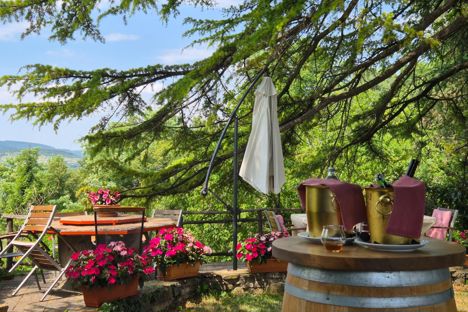
Discovering Istria: a gem of European gastronomy
White dusty roads lead intrepid gourmands across Croatia's westernmost peninsula to discover a region rich in gastronomic excellence with a unique culinary history
Discovering Istria: a gem of European gastronomy
White dusty roads lead intrepid gourmands across Croatia's westernmost peninsula to discover a region rich in gastronomic excellence with a unique culinary history
A country’s history has implications far beyond its political make up: it weaves its way into the fabric of an entire society, permeating through language, through generations of family, and of course, through food.
Across the world, these cuisines have been blended throughout history, with immigration, war, colonialism and the rise and fall of empires impacting the way societies, regions and entire nations eat.
Istria, the western Croatian peninsula, is not immune from the vicissitudes of conquering and fate. For a huge part of the peninsula’s history, it was under the rule of the Republic of Venice and before Venetian rule, the Romans controlled Istria, developing small cities like Pula and Rovinj to make them suitable for cross-Adriatic trade.
The Histri people – from where the peninsula derives its name – were said to have traded with their Mediterranean neighbours to the west more so than their Thracian cousins to the south, greater solidifying a Mediterranean connection, while the Franks, Hapsburgs and Byzantines each left indelible traces on the region's culinary and cultural identity.
That level of cultural exchange among Croatia's neighbours spans many centuries, and can still be felt today. Fuži pasta, a handmade shape not dissimilar from penne, is a mainstay, as is Maneštra, a soup similar to minestrone. Polenta too, found throughout Venetian and southern European recipes, is common in Istria. They all serve as reminders to Croatia's culinary history, the inflections which have impacted the region and how this became the gastronomy celebrated today.
Olive oil has been made in Istria since before the Romans. On the dozen-or-so islands that comprise the picturesque Brijuni national park, evidence of olive oil production from the Byzantine era still stands. As does an oven, over 2,000 years old, alongside vessels for the fermentation of wine. Istrians are, and always have been, a people with food, trade, and a respect for the land at their core.
Over the decades, Istria has slowly grown from a hotspot mostly known (and frequented by) western and southern Europeans, into a global destination in its own right, with world-leading gastronomy at the heart of any visit.
Snaking along the narrow white roads which connect the sporadic hilltops villages near picturesque Vrh and Hum (known as the world’s smallest town), secluded vineyards and idyllic restaurants begin to reveal themselves.
Nevio Sirotić runs one such restaurant. He goes by Nevio, or more often, maestro, and serves just a handful of tables a day (perhaps three or four at most). The restaurant, Tokalarija is open when he wants it to be and follows a formula of Istrian gastronomy. Things begin with a walk around the smallholding adjacent to the restaurant: only a few dozen rows of courgettes, brassicas, peas, herbs and tomatoes are planted. The operation is too small a plot for any restaurant bigger than Nevio’s, little wonder he only serves four tables.
That day the only table was reserved for us to savour the food, the views and the sound of the cicadas. Locally made hams with an even dispersion of fat that would make any charcutier swoon came with both a locally-made hard and soft ricotta cheese, honey from the garden and crisp, fried cauliflower.
The herb oil was rustic, cropped from a dill plant about 20 feet away. Maneštra soup, a mainstay of the Istrian diet, followed. The maestro stumbled upon his technique for this dish quite by accident; one day he forgot the beans for the maneštra were on the hob, stewing and bubbling away and when he returned from his morning’s work, he found they had disappeared. The stew had completely broken down all of the beans, creating a thickness and creaminess unlike any other maneštra. It went straight on the menu.
The pasta course is next, another Istrian staple. The dough is made fresh, to order, with just flour and water, rightfully centering local truffles as the star of the show.
As well as accompanying the sauce, truffles are shaved and sliced atop the completed pasta - these three executions dominate ones palate in the most pleasing way, further showcasing how high-end Istrian gastronomy is about how these ingredients come to be, rather than just the ingredients alone.
The lunch rounds off with a desperately light chocolate tart, alongside a crepe with strawberries from the garden. Punctuated by fabulous olive oil, framed by sparkling Malvasia wine and views beyond Buzet, the meal was as Istrian as could be.
20 years ago, very few Brits were visiting Istria. A decade ago and it was only the most informed gastronomic travellers making the pilgrimage. Today? Anyone with more than a passing interest in eating well will have Istria somewhere near the top of their 'to-visit' list.
Whereas Croatia more broadly might be the home of heavy potato dishes, goulash and hardy Slavic fare, Istria’s gastronomy is more closely related to its Italian heritage, with a unique Slavic-meets-Mediterranean twang.
While the Italian connection of the region is undeniable, the uniquely central European and Slavic accents which feature throughout the cuisine here mark Istria out in a unique and unexpected way.
Thinly sliced Boškarin tongue with ricotta feels carpaccio-adjacent, and deep stews of squid or spider crab are about as Mediterranean as it comes. There will likely be fresh red mullet; raw bass in lemon oil and plentiful black pepper; handmade fuži pasta regularly features.
Istria’s appeal as a destination beyond gourmands doesn’t approach that of Split, Hvar or Dubrovnik - despite its many Michelin-starred restaurants, its world leading olive oil, the exemplary Malvasia wine production and truffles that would make Alba and Piedmont jealous: Istria still feels like something of a European gem.
Alla Beccaccia is another restaurant steeped in local Istrian lore. Initially set up as a hunting lodge for snipe, the original owners gently expanded to become a full-service restaurant when demand for a post-hunt meal increased. Here, even in the 32 degree heat, a roaring fire feeds coals which top the peka: a traditional bell which is used to slow cook meat.
Here feasting upon local Boškarin cattle tongue, six-hour slow-cooked lamb with polenta and a rich fuži pasta made bright with capers and olives: understanding the culinary complexity and legacy of Istria has never been so easy.

